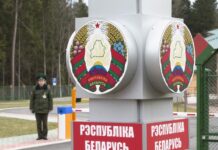
On November 27, Lithuanian Minister of the Interior Agnė Bilotaitė released this year’s report on migration trends. Illegal migration from Belarus is under control, but new activity has surfaced. Work-related immigration has increased, the ministrer announced, and new strategies are in place to balance attracting qualified workers, accepting political refugees and ensuring national security.
This is currently one of the greatest challenges facing the world, Europe and the region, said the minister, because illegal migration has become a weapon in the hands of dictators. Legal migration must also be closely monitored for threats to national security.
The number of foreigners living in Lithuania surpassed 200,000 for the first time in the country’s history. Last year, they were mostly war refugees from Ukraine and persecuted Belarusian citizens. This year the number of incoming Ukrainians has fallen, and there are 86,000 living there, as well as 62,000 Belarusians.
This year 50,000 foreign nationals came to work in Lithuania, mostly from Belarus, Uzbekistan, Ukraine, Kirghizia, Tadzikistan, Kazachstan and Azerbaijan. Darius Jauniškis, head of the State Security Department (VSD), noted that Lithuania is currently observing an unprecedented level of activity by the Belarusian KGB using immigrants from that country.
So far in 2023, 411 Belarusians lost their temporary residence permits, and 562 were refused such permits. Lithuanian border services denied entrance to 527 Russian citizens and 603 from Belarus.
Many new companies are being established, yet they do not employ, but “re-employ” foreign citizens for other firms. Employment practices are being abused because temporary residence permit holders are allowed to work, and employment of foreign nationals is not sufficiently regulated.
In order to control worker immigration, an interdepartmental work group will be established to review and update immigration policy. State Security recommends that immigration services in some countries be suspended. Regulations governing the legal status of foreigners will be revised, with stricter guidelines for businesses inviting foreign workers.
Current statistics show that pressure at the borders of the European Union continues, and 232,000 immigrants have entered th EU. Although the situation is somewhat more stable, there were 17% more illegal entries than last year. Most of those occurred in Italy, Hungary, Greece, Spain and Croatia.
Problems are increasing due to secondary migration among countries under the Schengen agreement, whereby 23 EU members and 4 non-members allow mutual freedom of movement. Eleven such countries have reestablished border controls.
Since August, Russians have been seeking asylum at border stations in Finland. With numbers of asylum-seekers increasing, Finland has closed seven border control points, leaving only one in the north. This situation may affect Norway and Estonia as well.
Changes are afoot for EU migration policy and laws to prevent these trends and alleviate what is called “instrumentalized” migration, whereby migrants are pushed across borders to destabilize or coerce the target state.






























